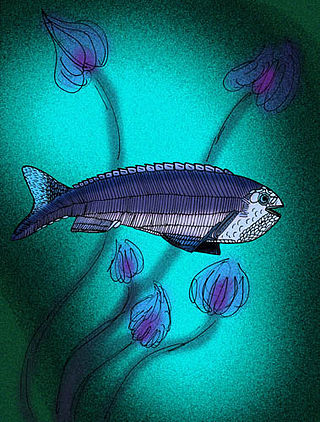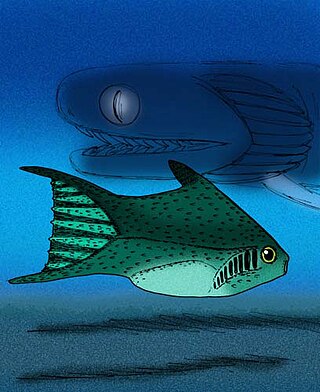
Agnatha is an infraphylum of jawless fish in the phylum Chordata, subphylum Vertebrata, consisting of both present (cyclostomes) and extinct species. Among recent animals, cyclostomes are sister to all vertebrates with jaws, known as gnathostomes.

Thelodonti is a class of extinct Palaeozoic jawless fishes with distinctive scales instead of large plates of armor.

Anaspida is an extinct group of evolutionarily underived jawless vertebrates that existed from the early Silurian period to the late Devonian period. They were classically regarded as the ancestors of lampreys. Anaspids were small marine agnathans that lacked a heavy bony shield and paired fins, but were distinctively hypocercal.

Thelodus is an extinct genus of thelodont agnathan that lived during the Silurian period. Fossils have been found in Europe, Asia and North America. Unlike many thelodonts, species of Thelodus are known not only from scales, but from impressions in rocks. Some species, such as the Canadian T. inauditus, are thought to be comparable in size to other thelodonts, i.e., from 5 to 15 centimeters in length. The scales of the type species, T. parvidens of Silurian Great Britain, however, reach the size of coins, and, if proportioned like other thelodonts, such as Loganellia, the living animal would have been about one meter in length.

Jamoytius kerwoodi is an extinct species of primitive, eel-like jawless fish that lived in the Llandovery epoch of the Early Silurian period.

The Palaeonisciformes (Palaeoniscida) are an extinct order of early ray-finned fishes (Actinopterygii). Palaeonisciformes sensu lato first appeared in the fossil record in the Late Silurian and last appeared in the Late Cretaceous. The name is derived from the Ancient Greek words παλαιός and ὀνίσκος, probably pertaining to the organization of the fishes' scales, similar to the exoskeletal plating of woodlice.

Phlebolepis is an extinct thelodont agnathan genus belonging to the family Phlebolepididae. Whole fossils are found in Late Silurian aged strata from Saaremaa, Estonia. Phlebolepis elegans was average-sized for a thelodont, 7 cm long.
Paleontology or palaeontology is the study of prehistoric life forms on Earth through the examination of plant and animal fossils. This includes the study of body fossils, tracks (ichnites), burrows, cast-off parts, fossilised feces (coprolites), palynomorphs and chemical residues. Because humans have encountered fossils for millennia, paleontology has a long history both before and after becoming formalized as a science. This article records significant discoveries and events related to paleontology that occurred or were published in the year 2004.
Andreolepis is an extinct genus of prehistoric fish, which lived around 420 million years ago. It was described by Walter Gross in 1968 based on scales found in the Hemse Formation in Gotland, Sweden. It is placed in the monogeneric family Andreolepididae and is generally regarded as a primitive member of the class Actinopterygii based on its ganoid scale structure; however some new research regards it as a stem group of osteichthyans.

Furcacauda is a genus of thelodontid agnathan from the Lower Devonian of Canada, and is the type genus of the order Furcacaudiformes. Furcacaudiform thelodontids were deep water jawless vertebrates with symmetrical fork and lobed-finned tails and scales smaller than typical loganellid and nikoliviid thelodonti scales. Furcacaudiform thelodonts are noted as having a laterally compressed body, large anterior eyes, slightly posterior, lateral, and vertical to a small mouth, and a condensed curved row of branchial openings (gills) directly posterior to the eyes. Many but not all had laterally paired fins. Wilson and Caldwell also note the presence of a caudal peduncle and a long caudal fin made of two large lobes, one dorsal and one ventral separated by 8 to 14 smaller intermediate lobes, giving the appearance of a striated half-moon shaped tail resembling the tail of a heterostracan. A large square cavity within the gut connecting a small intestine to an anal opening lead many to believe that it is this genus that exhibits the first vertebrate stomach. According to Wilson and Caldwell their discovery, based on sediment infillings of fossils of the Furcacauda heintze, gives credence to the evolutionary development of stomach before jaws.
Longodus is an extinct genus of thelodont, placed in its own family – Longodidae – which existed in what is now Estonia during the Ludlow epoch of the upper Silurian period. The type and only species is Longodus acicularis. They are most noted for their long, needle-like scales, which run vertically along their trunk.

Furcacaudiformes is an extinct order of jawless fish in the class Thelodonti.

Thelodontiformes is an extinct order of jawless fish of the Silurian.

Archipelepidiformes is an order of extinct jawless fishes in the class Thelodonti.

Phlebolepididae is an extinct thelodont agnathan family in the order Phlebolepidiformes.
Erepsilepis is an extinct thelodont agnathan genus in the family Phlebolepididae.
Cape October is a headland in Severnaya Zemlya, Russia.
Loganelliidae is an extinct family of thelodonts in the order Thelodontiformes. They are distinguished by the star or cross shaped ridges located on their head scales.
Oeselia mosaica is a fossil jawless fish and is the only species in its genus and in the family Oeseliidae. It is a member of an extinct family of thelodonts or jawless fishes. The family and genus were established along with the description of the species by Tiuu Märss in 2005.










